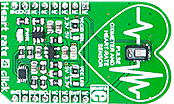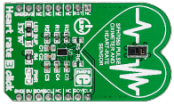|
|
| |
|
 | Search: |
|
|
 |

|
|
Heart rate 4 click carries the MAX30101 high-sensitivity pulse oximeter and heart-rate sensor from Maxim Integrated. The click is designed to run on either 3.3V or 5V power supply. It communicates with the target MCU over I2C interface, with additional functionality provided by INT pin on the mikroBUS™ line. |
|
|
|
|
 |

|
|
Heart Rate click carries Maxim's MAX30100 integrated pulse oximetry and heart-rate sensor. It's an optical sensor that derives its readings from emitting two wavelengths of light from two LEDs – a red and an infrared one – then measuring the absorbance of pulsing blood through a photodetector. This particular LED color combination is optimized for reading the data through the tip of one's finger. The signal is processed by a low-noise analog signal processing unit and communicated to the target MCU through the mikroBUS I2C interface. Developers of end-user applications should note that the readings can be negatively impacted by excess motion and changes in temperature. Also, too much pressure can constrict capillary blood flow and therefore diminish the reliability of the data. A programmable INT pin is also available. Uses 3.3V power supply. |
|
|
|
 |

|
|
Heart rate 3 click is a mikroBUS add-on board whose functionality is determined by two components: an OSRAM’s SFH7050 pulse oximetry and heart rate monitoring module, and a TI AFE4404 (analong-front-end) IC specialized for bio-sensing.
The SFH7050 multichip package contains 3 LEDs and one photodiode separated with a light barrier to prevent optical crosstalk. When the three LEDs shine through a subject’s finger, some of the light is absorbed by the pulsating blood.
The analog reading from the SFH7050 is forwarded to the AFE chip that is able to derive pulse readings from the intensity of the reflected light.
AFE4404 is highly-configurable and adaptable for different usage scenarios (different lighting conditions or skin tones) making Heart rate 3 click a robust heart rate monitoring solution.
The board communicates with the target MCU through the mikroBUS™ I2C interface, with additional functionality provided by RST, CLK and RDY pins.
Heart rate 3 click works on a 3.3V power supply, but an onboard jumper allows you to set the voltage for driving the SFH7050 LEDs at either 3.3V or 5V. |
|
|
|
 |
|
|

